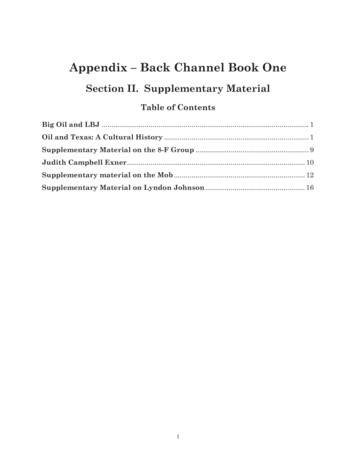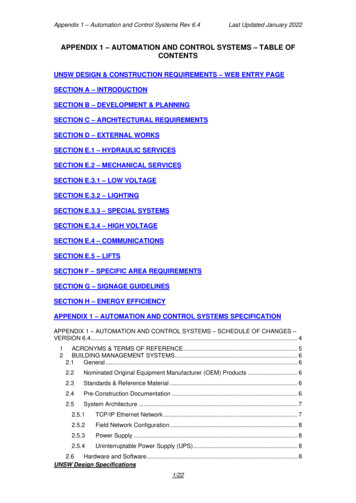
Transcription
Appendix – Back Channel Book OneSection II. Supplementary MaterialTable of ContentsBig Oil and LBJ . 1Oil and Texas: A Cultural History . 1Supplementary Material on the 8-F Group . 9Judith Campbell Exner. 10Supplementary material on the Mob . 12Supplementary Material on Lyndon Johnson . 161
Big Oil and LBJThe "Seven Sisters" was a term coined in the 1950s by Italian businessman EnricoMattei to describe the seven oil companies which formed the "Consortium for Iran"and dominated the global petroleum industry from the mid-1940s to the 1970s. Thegroup comprised Standard Oil of New Jersey and Standard Oil Company of NewYork (now ExxonMobil); Standard Oil of California, Gulf Oil and Texaco (nowChevron); Royal Dutch Shell; and Anglo-Persian Oil Company (now BP).In 1973 the members of the Seven Sisters controlled 85% of the world's petroleumreserves but in recent decades the dominance of them and their successorcompanies has been challenged by the increasing influence of the OPEC cartel andof state-owned oil companies in emerging-market ess/oil-and-texas-cultural-historyOil and Texas: A Cultural HistoryFor Texans, the 20th century did not begin on January 1, 1901, as it did foreveryone else. It began nine days later, on Jan. 10, when, spurting drilling pipe,mud, gas and oil, the Lucas No. 1 well blew in at Spindletop near Beaumont.The gusher spewed oil more than 100 feet into the air until it was capped nine dayslater. With that dramatic fanfare, Texas' economy was wrenched from its rural,agricultural roots and flung headlong into the petroleum and industrial age.When Franklin D. Roosevelt gained power he attempted to push a bill throughCongress that would give his Secretary of the Interior, Harold Ickes, the authorityto regulate domestic oil production. However, Sam Rayburn, a politician fromTexas, as chairman of the House Committee on Interstate and Foreign Commerce,was able to kill the bill. It was left to another powerful Texan, Tom Connally, tosponsor the Connally Hot Oil Act. This gave the Texas Railroad Commission theauthority to proration oil.Texas oil millionaires also fought hard to maintain its tax concessions. The mostimportant of these was the oil depletion allowance. It was first introduced in 1913and allowed producers to use the depletion allowed to deduct just 5 per cent of theirincome and the deduction was limited to the original cost of their property.However, in 1926 the depletion allowance was increased to 27.5 per cent.As Robert Bryce pointed out in his book, Cronies: Oil, the Bushes, and the Rise ofTexas, America's Superstate (2004): "Numerous studies showed that the oilmen1
were getting a tax break that was unprecedented in American business. While otherbusinessmen had to pay taxes on their income regardless of what they sold, theoilmen got special treatment."Bryce gives an example in his book how the oil depreciation allowance works. "Anoilman drills a well that costs 100,000. He finds a reservoir containing 10,000,000worth of oil. The well produces 1 million worth of oil per year for ten years. In thevery first year, thanks to the depletion allowance, the oilman could deduct 27.5 percent, or 275,000, of that 1 million in income from his taxable income. Thus, in justone year, he's deducted nearly three times his initial investment. But the depletionallowance continues to pay off. For each of the next nine years, he gets to continuetaking the 275,000 depletion deduction. By the end of the tenth year, the oilmanhas deducted 2.75 million from his taxable income, even though his initialinvestment was only 100,000."Such a system was clearly unfair and only benefited a small group of businessmenin Texas. It seemed only a matter of time before Congress removed this taxloophole. However, these oilmen used some of their great wealth to manipulate thepoliticians in Washington.1932 several politicians from Texas assumed important positions of power inWashington. John Nance Garner became Speaker of the House of Representatives.Texans also became the chairmen of some very important committees. This includedSamuel Rayburn (Interstate and Foreign Commerce), Joseph J. Mansfield (Riversand Harbors Committee), Hatton W. Sumners (Judiciary Committee), Marvin Jones(Agriculture Committee) and Fritz Lanham (Public Buildings and GroundsCommittee).As the historian, Robert A. Caro has pointed out in Lyndon Johnson: The Path toPower (1982): "Texans were elected on December 7, 1931, not only to theSpeakership of the House but to the chairmanship of five of its most influentialcommittees, Lyndon Johnson's first day in the Capitol was the day Texas came topower in it - a power that the state was to hold, with only the briefest interruptions,for more than thirty years."Sam Rayburn as chairman of the Interstate and Foreign Commerce Committee,played an important role in the establishing the and the Federal CommunicationsCommission. In 1937 Rayburn became majority leader and held the post for thenext three years.Several of these Texas politicians became involved in the Suite 8F Group, acollection of right-wing political and businessmen. The name comes from the roomin the Lamar Hotel in Houston where they held their meetings. Members of the2
group included George Brown and Herman Brown (Brown & Root), Jesse H. Jones(multimillionaire investor in a large number of organizations and chairman of theReconstruction Finance Corporation), Gus Wortham (American General InsuranceCompany), James Abercrombie (Cameron Iron Works), William Hobby (Governor ofTexas and owner of the Houston Post), William Vinson (Great Southern LifeInsurance), James Elkins (American General Insurance and Pure Oil Pipe Line),Albert Thomas (chairman of the House Appropriations Committee), Lyndon B.Johnson (Majority Leader of the Senate) and John Connally (Governor of Texas).Alvin Wirtz and Edward Clark, were two lawyers who were also members of theSuite 8F Group.Suite 8F helped to coordinate the political activities of other right-wing politiciansand businessmen based in the South. In this way they were able to prevent the oildepletion allowance removed. This sometimes meant that they supported theRepublican Party in elections. For example, Dwight D. Eisenhower receivedconsiderable funds from Texas oilmen in the 1952 presidential elections.Soon after being elected, Eisenhower stopped a grand jury investigation into the“International Petroleum Cartel” citing reasons of “national security”. Eisenhowerhad already starting paying back the generous support he had received from the oilindustry.In 1954 Paul Douglas began making speeches in the Senate about the need for taxreforms in order to eliminate special privileges such as the oil depletion allowance.Douglas attempted to join the important Finance Committee. He held senioritypriority and should have been given one of the two available seats on the committee.Johnson had to apply considerable pressure on Harry Byrd, the chairman of theFinance Committee, to stop this happening.In 1955 LBJ became majority leader of the Senate. LBJ and Richard Russell nowhad complete control over all the important Senate committees. This was proving tobe an expensive business. The money used to bribe these politicians came fromRussell’s network of businessmen. These were men usually involved in the oil andarmaments industries.According to John Connally, large sums of money was given to LBJ throughout the1950s for distribution to his political friends. “I handled inordinate amounts ofcash”. A great deal of this came from oilmen. Cornel Wilde worked for the Gulf OilCorporation. In 1959 he took over from David Searls as chief paymaster to LBJ. Hetestified that he made regular payments of 10,000 to Walter Jenkins.In 1956 there was another attempt to end all federal price control over natural gas.Sam Rayburn played an important role in getting it through the House ofRepresentatives. This is not surprising as according to Connally, he alone had been3
responsible for a million and a half dollars of lobbying.Paul Douglas and William Langer led the fight against the bill. Their campaignedwas helped by an amazing speech by Francis Case of South Dakota. Up until thistime Case had been a supporter of the bill. However, he announced that he hadbeen offered a 25,000 bribe by the Superior Oil Company to guarantee his vote. Asa man of principal, he thought he should announce this fact to the Senate.LBJ responded by claiming that Case had himself come under pressure to makethis statement by people who wanted to retain federal price controls. LBJ argued:“In all my twenty-five years in Washington I have never seen a campaign ofintimidation equal to the campaign put on by the opponents of this bill.”LBJ pushed on with the bill and it was eventually passed by 53 votes to 38.However, three days later, Eisenhower, vetoed the bill on grounds of immorallobbying. Eisenhower confided in his diary that this had been “the most flagrantkind of lobbying that has been brought to my attention”. He added that there was a“great stench around the passing of this bill” and the people involved were “soarrogant and so much in defiance of acceptable standards of propriety as to riskcreating doubt among the American people concerning the integrity ofgovernmental processes”.Senators called for an investigation into the lobbying of the oil industry by ThomasHennings, the chairman of the subcommittee on Privileges and Elections. LBJ wasunwilling to allow a senator not under his control to look into the matter. Instead heset up a select committee chaired by Walter F. George of Georgia, a member of theSouthern Caucus. Johnson had again exposed himself as being in the pay of the oilindustry.Drew Pearson of The Washington Post picked up on this story and wrote a series ofarticles about LBJ and the oil industry. Pearson claimed that LBJ was the “realgodfather of the bill”. Pearson explored LBJ’s relationship with George Brown andHerman Brown. He reported on the large sums of money that had been flowing fromBrown & Root, the “big gas pipeline company” to Johnson. He also referred to thelarge government contracts that the company had obtained during the SecondWorld War. Pearson also quoted a Senate report that pointed out there was “noroom for a general contractor like Brown & Root on Federal projects”.Nevertheless,LBJ had helped them win several contracts including one to build airnaval bases in Spain.”LBJ was now in serious trouble and sought a private meeting with Pearson. Heoffered the journalist a deal, if Pearson dropped the investigation, he would supportEstes Kefauver, in the forthcoming primaries. Pearson surprisingly accepted thisdeal. He wrote in his diary: “I figured I might do that much for Estes (Kefauver).4
This is the first time I’ve ever made a deal like this, and I feel unhappy about it.With the Presidency of the United States at stake, maybe it’s justified, maybe not –I don’t know.”The decision by Eisenhower to veto this bill angered the oil industry. Once againSid Richardson and Clint Murchison began negotiations with Eisenhower. In June,1957, Eisenhower agreed to appoint their man, Robert Anderson, as his Secretary ofthe Treasury. According to Robert Sherrill in his book, The Accidental President(1967): "A few weeks later Anderson was appointed to a cabinet committee to"study" the oil import situation; out of this study came the present-day programwhich benefits the major oil companies, the international oil giants primarily, byabout one billion dollars a year."During the 1960 presidential election JFK gave his support for the oil depletionallowance. In October, 1960, he said that he appreciated "the value and importanceof the oil-depletion allowance. I realize its purpose and value. The oil-depletionallowance has served us well."However, two years later, JFK decided to take on the oil industry. On 16th October,1962, JFK was able to persuade Congress to pass an act that removed thedistinction between repatriated profits and profits reinvested abroad. While thislaw applied to industry as a whole, it especially affected the oil companies. It wasestimated that as a result of this legislation, wealthy oilmen saw a fall in theirearnings on foreign investment from 30 per cent to 15 per cent.On 17th January, 1963, JFK presented his proposals for tax reform. This includedrelieving the tax burdens of low-income and elderly citizens. Kennedy also claimedhe wanted to remove special privileges and loopholes. He even said he wanted to doaway with the oil depletion allowance. It is estimated that the proposed removal ofthe oil depletion allowance would result in a loss of around 300 million a year toTexas oilmen.After the assassination of JFK, LBJ dropped the government plans to remove the oildepletion allowance. Richard Nixon followed his example and it was not until thearrival of Jimmy Carter that the oil depletion allowance was removed.5
In the last two decades of the 19th century,railroads had made sweeping changes in the livesof many of Texas' mostly rural, mostly agrariancitizens and forever altered the face of the state.Settlements formed around temporary railroadworkers' camps. Speculators created brand-newtowns out of virgin prairie beside the gleamingrails. And existing communities that werebypassed by the tracks often curled up theirmunicipal toes and died unless they were willingto pick up businesses, homes and churches andmove to the rails.The arrival of railroad transportation expandedTexas farmers' and ranchers' markets byproviding faster and cheaper shipping ofproducts. Cattle raisers were no longer forced totrail their herds long miles to railheads in theMidwest. In their classic Texas history text,Texas, the Lone Star State, Rupert Richardson,Ernest Wallace and Adrian Andersonsummarized it this way: “. railroads were thekey to progress and prosperity at the end of the19th century."When oil came gushing into Texas early in the20th century, the changes were even moreprofound. Petroleum began to displaceSpindletop blows in. Dallasagriculture as the principal engine driving theMorning News file photo.economy of the state, and Texans' lives were evenmore drastically affected than they had been by railroads.The impact of oil on Texas and Texans is often analyzed in terms of corporatedevelopment, personal and corporate wealth, and the overall economy of the stateand politics. Oil also dramatically affected the lives of those who owned the landfrom which oil was produced, or who were directly involved in oil exploration,extraction and processing. The discoveries of oil fields led to the founding andflourishing of numerous Texas towns, to the establishment of companies that havebecome multinational conglomerates, and to the amassing of vast personal fortunes.Conversely, the playing out of pumped-out oil fields led to the death of any numberof those once-flourishing towns. Betting fortunes on what turned out to be dustersresulted in the bankruptcies of companies and individuals.6
However, Texas oil has affected the lives of millions of Texans not directly involvedin the oil business – Texans who receive neither a paycheck nor a royalty checkbased on petroleum. Oil has profoundly changed the culture of the state, and itcontinues to affect most Texans' lives in ways that may not be obvious to the casualobserver.Early Oil DiscoveriesThe presence of natural oil seeps in Texas had been known for hundreds of yearsbefore Europeans arrived in the area. Indians in Texas are said to have toldEuropean explorers that the substance had medicinal uses. In July 1543, theremnants of Spanish explorer Hernando de Soto's expedition, led by Luis deMoscoso Alvarado, were forced ashore along the Texas coast between Sabine Passand High Island. Moscoso reported that the group found oil floating on the surfaceof the water and used it to caulk their boats.Lyne T. Barret drilled Texas' first producing oil well in 1866 at Melrose inNacogdoches County. The following year, Amory Reily Starr and Peyton F. Edwardsbrought in a well at nearby Oil Springs. Other wells followed, making NacogdochesCounty the site of Texas' first commercial oil field, first pipeline and first effort torefine crude. Several thousand barrels of oil were produced, but the price of oil wasnot high enough to justify further efforts at development. While drilling for water in1886, Bexar County rancher George Dullnig found a small quantity of oil, but he didnot attempt commercial production.City crews in Corsicana were also drilling for water in 1894, when they made thefirst economically significant oil discovery in Texas. That well was abandonedbecause the drillers needed to find water, not oil. But several producing oil wellswere drilled in 1895 by Joseph S. Cullinan, who later helped found the TexasCompany, which became Texaco. The first well-equipped refinery in Texas was builtat this field, and despite the early efforts at Nacogdoches, it is usually called Texas'first refinery.SpindletopThe oil discovery that jump-started Texas' transformation into a major petroleumproducer and industrial power was Spindletop. Exploration in the area of the upperGulf Coast near Beaumont had begun in 1892. After drilling several dry holes,Louisiana mining engineer and oil prospector Capt. Anthony F. Lucas drilled thediscovery well of the Spindletop field. Initially, the Lucas No. 1 produced more thanan estimated 75,000 barrels of oil a day. Peak annual production was 17.5 millionbarrels in 1902.Spindletop, which was also the first salt-dome oil discovery, triggered a flood ofspeculation in the area, resulting in several other significant discoveries. The boom7
included an influx of hundreds of eager wildcatters – including former GovernorJames Stephen Hogg – lusting after a piece of the action, as well as thousands ofworkers looking for jobs. Right behind them came a tidal wave of related service,supply and manufacturing firms, such as refineries, pipelines and oil-fieldequipment manufacturers and dealers. It was California's fabled Gold Rush of 50years earlier repeated on the Texas Gulf Coast with rotary drill bits and derricksinstead of pick axes and gold pans.The boom turned into a feeding frenzy of human sharks: scores of speculatorssniffing out a quick buck; scam artists peddling worthless leases; and prostitutes,gamblers and liquor dealers, all looking for a chunk of the workers' paychecks.Within three years, several additional major fields were developed within a 150mile radius of Spindletop; Sour Lake, Batson and Humble were among them.Companies were soon established to develop the Gulf Coast oil fields. Many of thembecame the industry giants of today: Gulf Oil; Sun Oil Company; MagnoliaPetroleum Company; the Texas Company; and Humble Oil, which later affiliatedwith Standard Oil of New Jersey and became Esso, then today's Exxon. Refineries,pipelines and export facilities became the nucleus of the major industrial regionthat began to form along the Texas coast around Port Arthur and Beaumont. TheNew Handbook of Texas summarizes the effect of Spindletop in this way: "Thediscovery of the Spindletop oil field had an almost incalculable effect on worldhistory, as well as Texas history. Eager to find similar deposits, investors spentbillions of dollars throughout the Lone Star State in search of oil and natural gas.The cheap fuel they found helped to revolutionize American transportation andindustry."Texas oil production was 836,039 barrels in 1900. In 1902, Spindletop aloneproduced more than 17 million barrels, or 94 percent of the state's production. As aresult of the glut, oil prices dropped to an all-time low of 3 cents a barrel, whilewater in some boom towns sold for 5 cents a cup.8
Supplementary Material on the 8-F GroupIn 1932, the 8-F Group was formed to coordinate the political activities of prominentright wing politicians and businessmen in the South. It was named after itslocation in suite 8-F in the Lamar Hotel in Houston, Texas. Membership was veryexclusive indeed and included such people as George and Herman Brown of Brownand Root; the Governor of Texas; chief executives and founders of major oilcompanies, insurance companies, pipe line companies; and prominent and powerfulpoliticians such as Albert Thomas, Chairman of the House AppropriationsCommittee, Subcommittee on Defense, etc. In 1960, members included RobertAnderson, president of the Texas Mid-Continent Oil and Gas Association; RobertKerr of Kerr-McGee Oil Industries; Billie Sol Estes, an entrepreneur in the cottonindustry; Glenn McCarthy of McCarthy Oil and Gas Company; Earl E. T. Smith, ofU.S. Sugar Corporation; Fred Korth, Continental National Bank and NavySecretary; Ross Sterling of Humble Oil; Texas oil magnates Sid Richardson andClint Murchison, Jr., H. L. Hunt of Placid Oil; Eugene B. Germany (Mustang OilCompany), David Harold Byrd, chairman of Byrd Oil Corporation; Lawrence D.Bell, of Bell Helicopter; William D. Pawley (business interests in Cuba), GordonMcLendon of KLIF; Senators George Smathers, Richard Russell, James Eastland,Benjamin Everett Jordan; and lobbyists Fred Black and Bobby Baker, also affiliatedwith the Serve-U Corporation. Lyndon Johnson and John Connally were alsomembers. Lawyers Alvin Wirtz and Edward Aubrey Clark were closely associatedwith the group.9
Judith Campbell ExnerEveryone from Frank Sinatra down has said that Judith Campbell Exner was afabulously beautiful woman when she was well known by the FBI to be the mistressof President John F. Kennedy.It was Sinatra who first introduced Exner to JFK in 1960. Although JFK is nowthought of as having had many mistresses, Exner was undoubtedly his mainsqueeze. No serious biography of JFKsince 1977 has failed to mention Exner.FBI Director J. Edgar Hoover hadExner tailed, not for any valid lawenforcement purpose, but rather to beable to blackmail JFK, just as Hooverhad blackmailed every previousPresident, going back to Warren G.Harding, the president who had firstappointed Hoover.Judith Campbell Exner was a friend ofMafia Don Sam Giancana and was oneof the president's lovers. In August1962, while the FBI watched herapartment, agents observed a break-ininto her apartment by two brotherswhose getaway car had been rented bytheir father, the chief of security atGeneral Dynamics. Three months later,the defense contractor, thought to bethe second choice to build anexperimental jet fighter, won the hugecontract.Exner has been treated unfairly byJudith Campbell Exnerhistory. She never sought to capitalizeoff the fact that she was JFK's mistress. She kept this hidden for years. Jackieknew about her, of course. Once, when Jackie found a woman's pink panties in herpillow case, she turned to JFK in bed and said, "Would you find out who thesebelong to, because they are not my size?"10
Although JFK was assassinated in 1963, it was not until 1975 that the identity ofExner was revealed. This happened when the Church Committee investigated thelink which Exner formed between JFK and Sinatra's friends, including Mafia donSam Giancana.11
Supplementary material on the MobSam Giancano and Carlos MarcelloNever invading Cuba did not preclude the United States from trying to hatch plansto assassinate Castro however. Normally, such assignments would be given directlyto the CIA’s “wet works” department (the counterpart of the KGB’s infamousDepartment 13 for which Gennady worked). In August 1960, two very highranking CIA officers – James O’Connell and Sheffield Edwards – approached formerFBI agent Robert Maheu (who had previously left the FBI to form his own“consulting agency”) and asked for his help in recruiting the Mafia to assassinateCastro. Maheu agreed and recruited mobster Johnny Roselli who in turn recruitedSam Giancana and Santos Trafficante. Both of the latter were on the FBI’s 10 MostWanted list but Giancana had a direct link to the President. On a 1960 campaigntrip to Los Vegas, Frank Sinatra introduced JFK to Judith Campbell Exner andtheir numerous amorous encounters (many at the White House) continued well intohis Presidency. Exner, however had been the girlfriend of Sam Giancana who wasnone too pleased to be replaced in her affections by Kennedy. Giancana also hadgood reason to want to see Castro assassinated. Giancana had enjoyed veryconsiderable Cuban casino income before Castro’s rise to power and he also hadplans for two other Cuban related businesses which had to be abandoned. The CIAand Roselli had toyed around with childish schemes, exploding cigars, poison pens,exploding conch shells (Castro loved scuba diving), etc. but Giancana was deadserious. He wanted to use poison. To create the deadly pill, the CIA turned to its“Office of Medical Services” which after considerable experimentation came up witha truly lethal poison pill by March 1961. That same month, through a series of CIApratfalls worthy of a Laurel and Hardy movie, the FBI found out about the plot toassassinate Castro and the two CIA officers plus Maheu were peremptorilysummoned to a meeting with Robert Kennedy. The Attorney General was furiousthat all this had been going on behind his back and that two mobsters on the FBI’s10 Most Wanted list were involved and that one of them was Sam Giancana. Bobbywas aware of is brother’s liaison with Judith Exner and Exner’s connection withGiancana. However, he also felt that the elimination of a Communist leader of acountry only 90 miles away from the United States would be most welcome.12
Perhaps those two elements combined in his decision to allow the operation tocontinue on the condition that he be kept closely informed.Giancana had devised a very workable plan which might well have succeeded had itnot been for a series of bumbles within the CIA itself where the ‘left hand wasunaware of what the right hand was doing.’Jimmy Hoffa, the head of the powerful Teamsters Union, was continuing to be theobject of what seemed almost like a personal vendetta being carried out against himby Robert Kennedy. Hoffa, who had very close ties to the mob reportedly once askedabout the possibility of a mob hit on Robert Kennedy but was advised thatPresident Kennedy would be so infuriated that even if Robert were killed, he wouldmost likely be replaced by someone even more vicious. Hoffa then inquired aboutthe possibility of killing the President.Another prominent mob figure that hated the Kennedys was Louisiana crime bossCarlos Marcello. Born to Sicilian parents in Tunisia in 1910, he was brought to theU.S. in 1911 and his family moved into a run-down house near Metarie, LA. Hequickly became involved in petty crime and armed robbery and after severalbrushes with the law, he received a nine year sentence to the Louisiana StatePenitentiary. He was released after five years. In 1938 he received another longprison sentence for selling more than 23 pounds of marijuana and fined almost 77,000. He was released from prison less than 10 months later. He then becameassociated with Frank Costello who was capo of the Genovese crime family in NewYork. Costello was involved in transporting illegal slot machines from New York toNew Orleans and Marcello provided the muscle and arranged for the machines to beplaced in local businesses.From Wikipedia we learn:“By the end of 1947, Marcello had taken control of Louisiana's illegalgambling network. He had also joined forces with New York Mob associateMeyer Lansky in order to skim money from some of the most importantcasinos in the New Orleans area. According to former members of theChicago Outfit, Marcello was also assigned a cut of the money skimmed fromLas Vegas casinos, in exchange for providing "muscle" in Florida real estatedeals. By this time, Marcello had been selected as the "Godfather" of theNew Orleans Mafia, by the family's capos and the Commission. He was tohold this position for the next 30 years.13
On March 24, 1959, Marcello appeared before a United States Senatecommittee investigating organized crime. Serving as Chief Counsel to thecommittee was Robert F. Kennedy; his brother, Senator John F. Kennedy,was a member of the committee. In response to committee questioning,Marcello invoked the Fifth Amendment to the United States Constitution, inrefusing to answer any questions relating to his background, activities andassociates.In 1960, Marcello donated 500,000 through Teamsters Union presidentJimmy Hoffa, to the Republican campaign of Richard M. Nixon, challengingthe Democrat John F. Kennedy.In March 1961 Attorney General Robert Kennedy, acting on requests whichhad been first made to the Eisenhower administration by former Louisianastate police superintendent Francis Grevemberg, took steps to deportMarcello to Guatemala (the country Marcello had falsely listed as hisbirthplace). On April 4, of that year, Marcello was arrested by the authoritiesand taken forcibly to Guatemala.Marcello soon returned to the United States. Undercover informants reportedthat Marcello made several threats against John F. Kennedy, at one timeuttering the traditional Sicilian death threat curse, "Take the stone from myshoe". In September 1962, Marcello told private investigator Edwin NicholasBecker that, "A dog will continue to bite you if you cut off its tail.," (meaningAttorney General Robert Kennedy.), ".whereas if you cut off the dog'shead.," (meaning President Kennedy), ". it would cease to cause trouble".Becker reported that Marcello,
Oil and Texas: A Cultural History . Supplementary Material on Lyndon Johnson.16 1. Big Oil and LBJ The "Seven Sisters" was a term coined in the 1950s by Italian businessman Enrico . group comprised Standard Oil of New Jersey and Standard Oil Company of New York (now ExxonMobil); Standard Oil of California, Gulf Oil and Texaco (now











